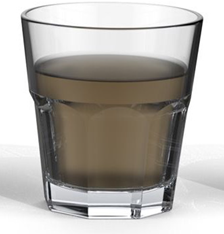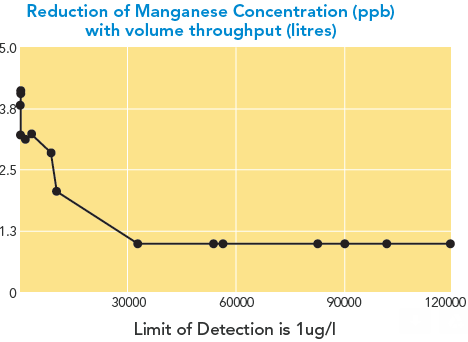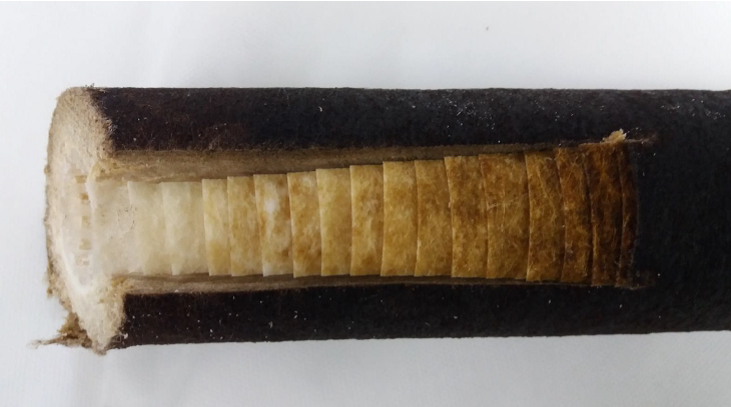Table of Contents
The Problem
Relatively low manganese levels in water can result in tainting of taste as well as discoloration of the water and the surfaces it comes into contact with. The Drinking Water Inspectorate (DWI) in the United Kingdom have set a maximum allowable limit of 50ppb, well below the WHO guidelines of 400ppb. While the WHO regulations are based on health concerns of the bioavailable form of manganese the DWI regulations are concerned with providing drinking water at the point of use which also looks healthy and tastes good i.e. free from discolouration and taint.

The 50ppb limit set by the DWI was intended to ensure that discolouration and taste tainting was acceptable to the consumer. However, recent studies conducted by Welsh Water and Severn Trent have shown that levels as low as 2ppb can still be problematic at the point of use.
Flushing pipework to remove the contamination on a regular basis is time consuming, disruptive to the consumer and expensive. In an attempt to develop a more viable treatment system that can produce water with a manganese concentration below 2ppb Welsh Water partnered with Amazon Filters Ltd to look at an alternative technology.
Existing Methods of Removal
Most methods of removal rely on the oxidation of Mn(II) to Mn(IV) to precipitate out the manganese for subsequent removal through a filter bed of sand. Precipitation is typically achieved by adjusting the pH to 7 and chlorinating to ensure a residual of chlorine downstream of the filter. The capital cost of these system based on sand beds can be very high and mean treatment at multiple bore holes or surface water resources is just not viable.
Amazon Filters worked closely with Welsh Water to see if using cartridge filtration technology could result in a more viable, flexible option.
The Solution
The results of the first round of testing have shown that a system based on polymeric cartridge filters instead of traditional sand beds can lead to below detectable limits of manganese with an estimated overall installation cost 25% that of a traditional sand bed system.
This has been achieved using a polymeric filter composing of meltblown fibres that have proved to be highly effective at promoting the ‘seeding’ of the precipitated manganese. This ‘seeding’ on the fibres establishes areas that accelerate the removal of manganese through a catalytic process. By selecting a filter with the correct combination of fibre diameters, efficiency and water flux, the optimised system in terms of removal and lifetime can be achieved.
Test Protocol/Results
A small side stream filter was set up to process a proportion of the water from a borehole after chlorination and pH adjustment. The initial manganese level was recorded at between 4 and 5ppb before treatment. While this is well inside the DWI regulations it was still in a concentration above that known to cause problems in the distribution network.
Flowrates were maintained during the testing between 8 and 10l/min/10” filter.
Measurement of manganese levels were recorded by submitting samples to Welsh Water’s laboratories over an initial test period of 2 weeks. Over this time a marginal decrease in levels was recorded. Water continued to flow through the filter system for a further 2 weeks. Samples were then taken and analysed and the filtrate levels of manganese had dropped to below detectable limits.


Conclusion
Two different filter constructions were tested to establish the optimal design with respect to retention and lifetime. While these tests were limited to just one bore hole, the results are so encouraging that additional filter systems have been ordered by Welsh Water to replicate the performance at other bore and surface water locations.
To better understand the mechanisms of removal more fully and therefore have the ability to further improve and optimise the system, Welsh Water are looking to conduct a University research project in the near future. It is hoped this will lead to further improvements in design, installation and operation of the filtration system.
Budget proposals for a system to process all the borehole water (8.4Ml/d) have been completed and indicate a saving in the order of 75% over a traditional sand bed installation. This saving is in conjunction with guaranteeing manganese levels below 1ppb and reducing the amount of manganese entering the distribution by 30kg/year.
Author: David Ridealgh
References:
- A 2014 report entitled ‘Specification of Manganese in Drinking Water’ published but the Drinking Water Inspectorate in the Uk (WRc Ref: UC9780)
- Severn Trent Water https://www.waterindustryjournal.co.uk/reducingcustomer-discolouration-complaints-by-controlling-manganese-at-watertreatment-works
